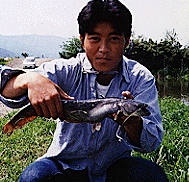TWO DEATHS, NO JUSTICE
PAGE 2 OF 5
| "A boy's life was needlessly snuffed by the thoughtless, blind triggering of a .44 magnum wielded by a frightened resident -- and the crowd cheered." |
Lee was struck in the lower right abdomen by a projectile that tore a quarter-sized hole in his gut and lodged near his spine. He was rushed to a local hospital, the New Hanover Regional Medical Center, but doctors were unable to stem the massive bleeding during the five hours of surgery. Lee was declared dead at 1:04 p.m., about 12 hours after the shooting.
Initially it was believed that Lee was somehow struck by a fragment from a squib, the small explosive device used to simulate a bullet impact. The squib was wired into a grovery sack that Lee was carrying during his final scene. Only after pathologists pulled a .44-caliber bullet from his body did people make the connection between the prop gun and Lee's demise.
Was his death merely due to tragic oversight on the part of the studio's prop personnel? The District Attorney's office apparently thought so. Authorities dismissed the possibility of premeditated murder and declined to charge any crew member with criminal neglect. The production company, Crowvision, may still be forced to pay unspecified fine for its part in the tragedy, and Linda Lee Cadwell, Brandon's mother, is suing several parties, including Crowvision and its parent company, Edward R. Pressman Film Corp, for negligence in her son's "agonizing pain, suffering and untimely death."
Lingering doubts about this so-called accident remain. The scenario outlined in Cadwell's lawsuit suggests that a bullet was accidentally lodged in the barrel of the weapon when the gunw was used in the filming of a scene several weeks earlier. The bullet remained wedged in the barrel until it was propelled by blank ammunition into Brandon's stomach during the fateful scene on April 1, according to Cadwell's lawsuit.
The lawsuit alleges that the bullet was jammed into the barrel because crew members improperly manufactured their own dummy bullets (used in close-ups of the handgun) from live ammunition rather than waiting to buy them from a licensed firearms dealer.

Yoshi Hattori was a 16-year-old exchange student from Nagoya, Japan.
To create a makeshirt dummy bullet from live ammunition, crew members would have pried the bullet tip from the casing and emptied the gunpowder. Then the tip would have been reattached to the empty casing, creating an impotent but realistic-looking cartridge. Because primer (the combustible powder that ignites the gunpowder would still remain in the cartridge, the weapons handler would fire the gun until all of the primers had been detonated.
According to one publication's explanation of the incident, the primer in one of the dummy bullets was left intact although a weapons handler fired the pistol several times to detonate the primers. Moreover, the magazine asserts that this dummy bullet contained enough gunpowder residue to cause an explosive burst strong enough to drive the bullet tip into the barrel.
An actor who used the firearm in an earlier scene is alleged to have test-fired the gun, causing the small explosion that lodged the bullet into the barrel. When the dummy bullets were removed from the revolver's cylinder, no one apparently found it remarkable that one of them was missing its tip.
Although this scenario has been embraced by some publications and the Cadwell family, some gun experts remain skeptical.
"I really have my doubts," says Bob Forker, the technical editor for Guns & Ammo magazine. The problem with that scenario, he explains, is that primer and gunpowder residue wouldn't provide enough explosive power to drive a bullet completely into the barrel. The rifling of the barrel, which is necessary to impart spin on the bullet, creates a very strong resistance, Forker says.
The implausible combination of alleged oversights by the crew also bothers Forker. Each miscue alleged in the lawsuit could have been nullified by an observant crew member at any point during the fateful chain of events. Yet time after time the crew apparently ignored strict gun-handling procedures and safety checks that should have been second nature to them. PAGE 3
CONTACT US
|
ADVERTISING INFO
© 1996-2013 Asian Media Group Inc
No part of the contents of this site may be reproduced without prior written permission.
